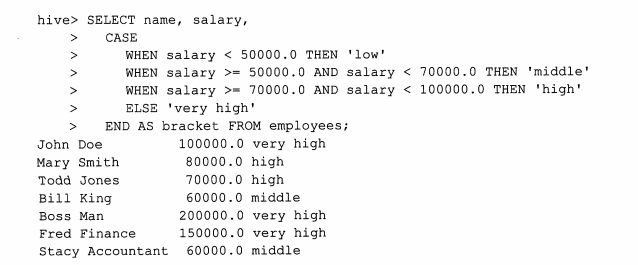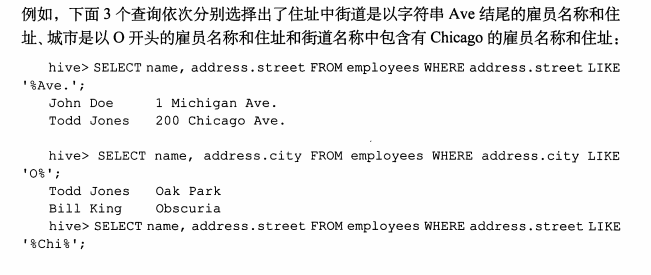select symbol, "price.*" from stocks :使用正则表达式来指定列查询
select count(*), avg(salary) from emplyee: 聚合函数
select count(distinct col) from stocks:去重后的数目
嵌套查询:
from(select upper(name), salary,deductions["Federal Taxes"] as fed_taxes,round(salary*(1-deductions["Federal Taxes"])) as salary_minus from employees) e select e.name, e.salary_mines,where e.salary_minus>70000;
case...when...then...查询

like语句查询:

Rlike语句

group by 语句
group by 语句通常会和聚合函数一块使用,按照一个或者多个列对结果进行分组,然后对每个分组进行聚合操作。

Hive中的order by 和sort by 的区别:
order by执行的是一个全局排序,也就是说也就是说所有的数据都是通过一个Reducer来排序的,对于大数据集来说,话费很长世间,而sort by是局部排序,在每个Reducer中对数据进行排序,也就是说在每个Reducer中是有序的,但是所有Reducer合起来,就是局部有序。

Union all
Union all 可以将2个或者多个表进行合并。但是每一个Union 子查询必须有相同的列,而且每个字段的类型必须是一样的。


下面是hive当中的一些常用函数:
数据函数,集合函数,类型转化函数,日期函数,,条件函数,字符函数,聚合函数,表生成函数。
from_unixtime(bigint unixtime[, string format]):将时间秒值转化为Format格式的时间
例如:from_unixtime(1250111000,"yyyy-MM-dd") 得到2009-03-12
unix_timestamp(string date, string pattern):将format格式的时间字符串转化为时间戳:
例如:unix_timestamp('2009-03-20 11:30:01') = 1237573801
python工具:
数据预览:
df.head(n); df.info(); df.describe(); df.tail()
df.columns:行名
df.index:列名
train.shape
train.dtypes
pd.concat([train, test],ignore_index=True)
only_western_europe_10 = (reprot_2016_df['地区'] == 'Western Europe') & (reprot_2016_df['排名'] > 10)
df.set_index(['Region', 'Country']):设置层级索引
数据清洗
log_data.isnull():是否缺失
log_data[log_data['volume'].notnull()]:取出volume不为空的数据
log_data.fillna(0):填充缺失数据为0
log_data.dropna():去掉有缺失数据的记录
log_data.ffill():以前面的数据填充
log_data.bfill():以后面的数据填充
data.duplicated():判断是否重复
data.drop_duplicates():去除重复数据
map:使用
meat_to_animal = {
'bacon': 'pig',
'pulled pork': 'pig',
'pastrami': 'cow',
'corned beef': 'cow',
'honey ham': 'pig',
'nova lox': 'salmon'
}
lowercased = data['food'].str.lower()
data['animal'] = lowercased.map(meat_to_animal)
或者:
data['food'].map(lambda x: meat_to_animal[x.lower()])
# 将-999替换为空值
data.replace([-999, -1000], np.nan):将列表里的数替换为nan
split_df = data.str.split('@', expand=True):str各种函数
pd.merge(staff_df, student_df, how='outer', on='姓名'):合并df,可选择左右内外连接
staff_df['员工姓名'].apply(lambda x: x[0]):apply的使用
report_data.groupby('Region')grouped['Happiness Score'].mean():后面的聚合函数是对每个分组进行操作的
# 迭代groupby对象
for group, frame in grouped:
mean_score = frame['Happiness Score'].mean()
max_score = frame['Happiness Score'].max()
min_score = frame['Happiness Score'].min()
grouped.agg({'Happiness Score': np.mean, 'Happiness Rank': np.max}):分组的聚合函数
grouped['Happiness Score'].agg([mean, amax, amin, std]):分组的聚合函数
绘图:matplotlib 和 seaborn工具:
%matplotlib notebook:魔法命令
plt.style.available:可用的绘图样式
plt.style.use('seaborn-colorblind'):设置绘图样式
df.plot():分别以每一列为纵轴,索引为横轴,画曲线图,并以图例区别开来
df.plot('A', 'B', kind='scatter'):指定A为横轴,B为纵轴
df.plot(kind='box'):kind可以为hist,kde
pd.plotting.scatter_matrix(iris):散点距阵,查看各个特征之间的相关性
sns.pairplot(iris, hue='Name', diag_kind='kde'):查看各个特征之间的相关性
特征工程:
归一化:
scaler = MinMaxScaler()
X_train_scaled = scaler.fit_transform(X_train)
X_test_scaled = scaler.transform(X_test)
标签编码和独热编码:
首先训练集:
# 在训练集上进行编码操作
label_enc1 = LabelEncoder() # 首先将male, female用数字编码
one_hot_enc = OneHotEncoder() # 将数字编码转换为独热编码
label_enc2 = LabelEncoder() # 将low, middle, high用数字编码
tr_feat1_tmp = label_enc1.fit_transform(X_train[:, 0]).reshape(-1, 1) # reshape(-1, 1)保证为一维列向量
tr_feat1 = one_hot_enc.fit_transform(tr_feat1_tmp)
tr_feat1 = tr_feat1.todense()
tr_feat2 = label_enc2.fit_transform(X_train[:, 1]).reshape(-1, 1)
X_train_enc = np.hstack((tr_feat1, tr_feat2))
然后再测试集上:
te_feat1_tmp = label_enc1.transform(X_test[:, 0]).reshape(-1, 1) # reshape(-1, 1)保证为一维列向量
te_feat1 = one_hot_enc.transform(te_feat1_tmp)
te_feat1 = te_feat1.todense()
te_feat2 = label_enc2.transform(X_test[:, 1]).reshape(-1, 1)
X_test_enc = np.hstack((te_feat1, te_feat2))
模型持久化:
# 保存模型到硬盘
model_path2 = './trained_model2.pkl'
joblib.dump(best_model, model_path2)
model = joblib.load(model_path2)
日期特征处理:
train['created'] = pd.to_datetime(train['created'])
train['date'] = train['created'].dt.date
train["year"] = train["created"].dt.year
train['month'] = train['created'].dt.month
train['day'] = train['created'].dt.day
data[v].value_counts():列举不同的取值,以及每种取值的次数
data.drop(['Loan_Amount_Submitted','Loan_Tenure_Submitted'],axis=1,inplace=True):删除某列
df_train_origin[['temp','weather','windspeed','day', 'month', 'hour','count']].corr():相关性
pd.get_dummies(all_df['MSSubClass'], prefix='MSSubClass'):独热编码一键搞定
all_dummy_df.isnull().sum().sort_values(ascending=False):统计各个字段的空值数目
all_dummy_df.isnull().sum().sum():各个字段的总空值数
合并之后的数据重新分开:
dummy_train_df = all_dummy_df.loc[train_df.index]
dummy_test_df = all_dummy_df.loc[test_df.index]
df.unstack() 行索引→列索引
df.stack() 列索引→行索引